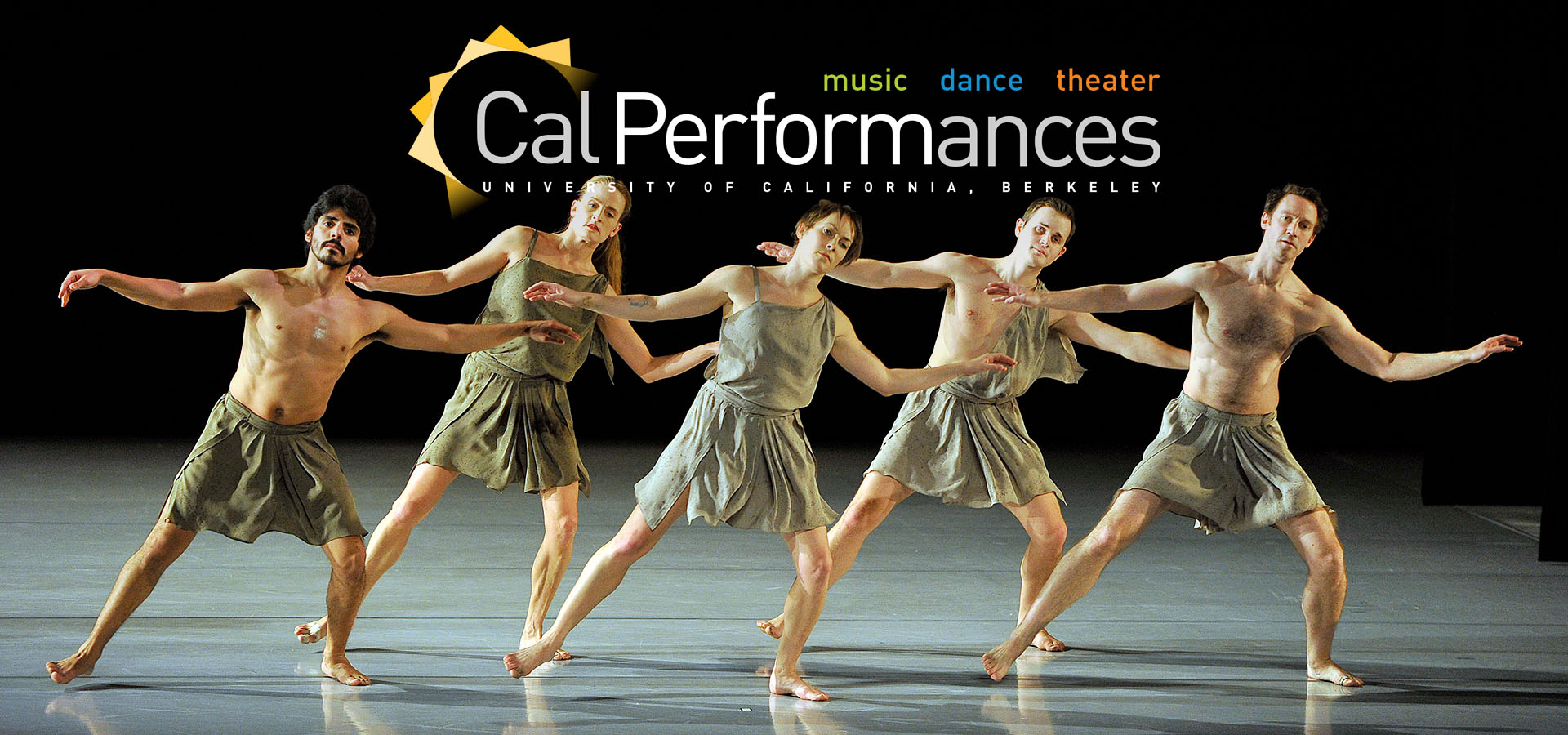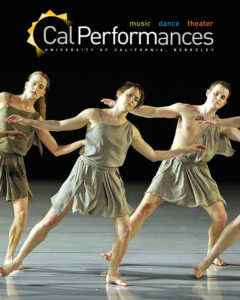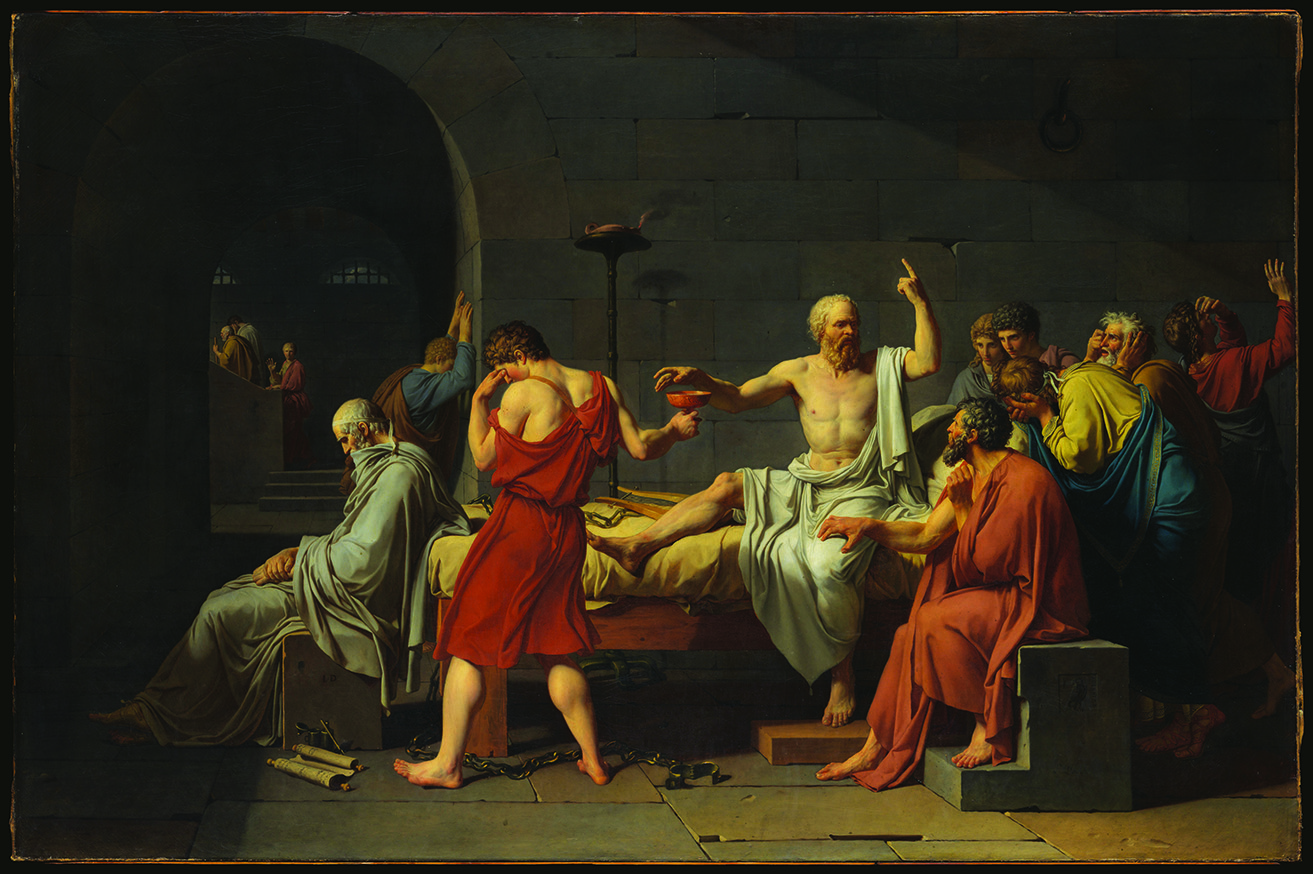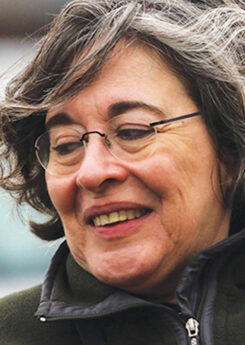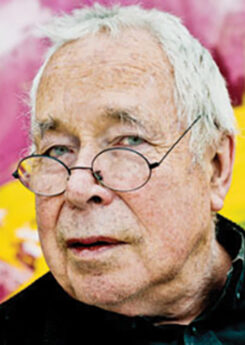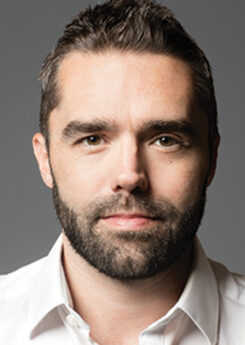Mark Morris Dance Group
Friday and Saturday, April 19–20, 2024, 8pm
Sunday, April 21, 2024, 3pm
Zellerbach Hall
These performances are made possible, in part, by Helen and John Meyer.
Cal Performances is committed to fostering a welcoming, inclusive, and safe environment for all—one that honors our venues as places of respite, openness, and respect. Please see the Community Agreements section on our Policies page for more information.
From the Executive and Artistic Director

As we enter the final weeks in Cal Performances’ 2023–24 season, it’s natural to take a look back and remember the highlights of a truly remarkable eight months at UC Berkeley. We will all have our favorite moments—instances when a performance seemed to leap off the stage and speak to us directly. But if such experiences are deeply personal, they also all depend on the communal act of gathering together and opening our eyes, ears, and hearts to the miracle of artistic expression. Every day throughout the world, people come to performances to celebrate what it means to be human in an increasingly impersonal world. As this particular season winds down, let me thank each and every one of you for taking part in the magic of great—and live!—music, theater, and dance.
Once again, April means one thing in particular at Cal Performances—Ailey Week—when the renowned Alvin Ailey American Dance Theater returns for its annual spring residency. With its relationship with UC Berkeley now in its 56th year (Ailey has visited campus every non-pandemic year since 1968), the company will present five separate programs from April 2 through April 7. The centerpiece of this year’s residency is the 2024 Gala on Thursday, April 4, with all proceeds benefiting Cal Performances’ artistic initiatives and education programs. During the week, we will also present an Ailey SchoolTime performance for K–12 students and provide an opportunity for alumni of Berkeley/Oakland AileyCamp to reconnect with company members. On opening night, Tuesday, April 2, I’m especially proud that Cal Performances will offer live audio descriptions and a pre-performance haptic tour for blind and visually impaired audience members.
As the season draws to a close in early May, we still have much to look forward to: gifted early-music artists like countertenor Jakub Józef Orliński with the acclaimed ensemble Il Pomo d’Oro (Apr 9) and Jordi Savall with Hespèrion XXI (Apr 12); the thunderous traditional taiko drumming of Drum Tao (Apr 11–12); superb chamber music with the Danish String Quartet and guest cellist Johannes Rostamo (Apr 13) and French ensemble Quatuor Ébène (Apr 16); a duo vocal recital with opera stars (and a husband-and-wife team to boot!) soprano Amina Edris and tenor Pene Pati, with Robert Mollicone at the piano (Apr 23); a highly anticipated return to campus by one of the most adventurous artists on the international pop music scene, the always astonishing Angélique Kidjo (Apr 26); astounding Icelandic pianist Víkingur Ólafsson in a special performance of J.S. Bach’s immortal Goldberg Variations (May 4); and an evening with America’s preeminent humor writer—and frequent guest of Cal Performances—David Sedaris (May 5).
And I must make special mention of the upcoming visit by our dear friends at the Mark Morris Dance Group (Apr 19–21), returning to their West Coast home away from home with a profoundly moving repertory work (2010’s Socrates) and the world premiere of a new Mark Morris creation, Via Dolorosa, set to Nico Muhly’s meditative composition The Street (performed live by harpist Parker Ramsay). In the more than 35 years since the company first appeared at UC Berkeley, Mark Morris’ dancers have treated Cal Performances audiences to the premieres of more than a dozen new Morris works, many of which have gone on to become company classics—don’t miss this chance to be part of dance history!
Finally, I hope you’ll join us on April 16, when we announce our extraordinary 2024–25 season. One major detail has already been announced—the Maria Manetti Shrem and Elizabeth Segerstrom California Orchestra Residency, when Cal Performances and the Philharmonic Society of Orange County will bring the world renowned Vienna Philharmonic and conductor Yannick Nézet-Séguin to California during spring 2025. And I can promise you many more welcome and exciting surprises when full season details are announced.
Again, thank you for joining us this season. I look forward to seeing you again in the fall.
Jeremy Geffen
Executive and Artistic Director, Cal Performances
 As we enter the final weeks in Cal Performances’ 2023–24 season, it’s natural to take a look back and remember the highlights of a truly remarkable eight months at UC Berkeley. We will all have our favorite moments—instances when a performance seemed to leap off the stage and speak to us directly. But if such experiences are deeply personal, they also all depend on the communal act of gathering together and opening our eyes, ears, and hearts to the miracle of artistic expression. Every day throughout the world, people come to performances to celebrate what it means to be human in an increasingly impersonal world. As this particular season winds down, let me thank each and every one of you for taking part in the magic of great—and live!—music, theater, and dance.
As we enter the final weeks in Cal Performances’ 2023–24 season, it’s natural to take a look back and remember the highlights of a truly remarkable eight months at UC Berkeley. We will all have our favorite moments—instances when a performance seemed to leap off the stage and speak to us directly. But if such experiences are deeply personal, they also all depend on the communal act of gathering together and opening our eyes, ears, and hearts to the miracle of artistic expression. Every day throughout the world, people come to performances to celebrate what it means to be human in an increasingly impersonal world. As this particular season winds down, let me thank each and every one of you for taking part in the magic of great—and live!—music, theater, and dance.
Once again, April means one thing in particular at Cal Performances—Ailey Week—when the renowned Alvin Ailey American Dance Theater returns for its annual spring residency. With its relationship with UC Berkeley now in its 56th year (Ailey has visited campus every non-pandemic year since 1968), the company will present five separate programs from April 2 through April 7. The centerpiece of this year’s residency is the 2024 Gala on Thursday, April 4, with all proceeds benefiting Cal Performances’ artistic initiatives and education programs. During the week, we will also present an Ailey SchoolTime performance for K–12 students and provide an opportunity for alumni of Berkeley/Oakland AileyCamp to reconnect with company members. On opening night, Tuesday, April 2, I’m especially proud that Cal Performances will offer live audio descriptions and a pre-performance haptic tour for blind and visually impaired audience members.
As the season draws to a close in early May, we still have much to look forward to: gifted early-music artists like countertenor Jakub Józef Orliński with the acclaimed ensemble Il Pomo d’Oro (Apr 9) and Jordi Savall with Hespèrion XXI (Apr 12); the thunderous traditional taiko drumming of Drum Tao (Apr 11–12); superb chamber music with the Danish String Quartet and guest cellist Johannes Rostamo (Apr 13) and French ensemble Quatuor Ébène (Apr 16); a duo vocal recital with opera stars (and a husband-and-wife team to boot!) soprano Amina Edris and tenor Pene Pati, with Robert Mollicone at the piano (Apr 23); a highly anticipated return to campus by one of the most adventurous artists on the international pop music scene, the always astonishing Angélique Kidjo (Apr 26); astounding Icelandic pianist Víkingur Ólafsson in a special performance of J.S. Bach’s immortal Goldberg Variations (May 4); and an evening with America’s preeminent humor writer—and frequent guest of Cal Performances—David Sedaris (May 5).
And I must make special mention of the upcoming visit by our dear friends at the Mark Morris Dance Group (Apr 19–21), returning to their West Coast home away from home with a profoundly moving repertory work (2010’s Socrates) and the world premiere of a new Mark Morris creation, Via Dolorosa, set to Nico Muhly’s meditative composition The Street (performed live by harpist Parker Ramsay). In the more than 35 years since the company first appeared at UC Berkeley, Mark Morris’ dancers have treated Cal Performances audiences to the premieres of more than a dozen new Morris works, many of which have gone on to become company classics—don’t miss this chance to be part of dance history!
Finally, I hope you’ll join us on April 16, when we announce our extraordinary 2024–25 season. One major detail has already been announced—the Maria Manetti Shrem and Elizabeth Segerstrom California Orchestra Residency, when Cal Performances and the Philharmonic Society of Orange County will bring the world renowned Vienna Philharmonic and conductor Yannick Nézet-Séguin to California during spring 2025. And I can promise you many more welcome and exciting surprises when full season details are announced.
Again, thank you for joining us this season. I look forward to seeing you again in the fall.
Jeremy Geffen
Executive and Artistic Director, Cal Performances
SOCRATE (“Socrates”)
Libretto
Text: Plato
Translation: Roger Nichols © 1985
Portrait de Socrate (“The Portrait of Socrates”)
Text taken from Plato’s Symposium
Alcibiades: So, my dear friends, in order to praise Socrates I shall have to resort to comparisons: maybe he will think I’m trying to be whimsical, but I’m being utterly serious. First of all, I must say that he looks just like those busts of Silenus you see in sculptors’ workshops, the ones usually shown with a flute or pan‐pipes in their hands; they are made of two separate pieces, and when you open them up you find statues of gods inside. Secondly, I reckon he is very like the satyr Marsyas—you play the flute, too, don’t you? And indeed you are a more remarkable performer than Marsyas. He used to delight his listeners with the beautiful sounds he drew from his instruments, as does anyone today who repeats his melodies; in fact, the tunes Olympus used to play, I attribute them to Marsyas his teacher. The only difference, Socrates, between Marsyas and you is that without any instruments, just by talking, you produce the same effect.
For my part, my friends, if I wasn’t afraid you would think me completely drunk, I would dilate upon the extraordinary effect his words have had on me, and still do have.
When I listen to him I feel my heart beating faster than if excited by the wild frenzy of the Bacchic rites, his words make tears roll down my cheeks and I know many others who experience the same feelings.
That is the effect on me and many others of this satyr’s flute.
Socrates: So much for your kind words about me. Now it is my turn to praise the companion on my right.
Bords de I’llissus (“The Banks of the Illissus”)
Text taken from Plato’s Phaedrus
Socrates: Let us turn off the road a little and, if you like, we’ll walk along the banks of the Illissus and find a quiet place where we can sit down.
Phaedrus: Really, I’m glad I came out today without my sandals. I know it’s the usual thing for you. Now we can go into the river itself and bathe our feet and walk along at the same time. That would be a real pleasure, especially in this weather and at this time of day.
Socrates: I agree. Lead on then, and look out for somewhere to sit down.
Phaedrus: Do you see that tall plain tree?
Socrates: Yes?
Phaedrus: There’ll be some shade there and a light breeze and some grass. We can sit down or even lie down if we want to.
Socrates: On you go. I’ll follow.
Phaedrus: Tell me, Socrates, wasn’t it somewhere here on the banks of the Illissus, according to the legend, that Boreas kidnapped the young Oritheia?
Socrates: So we are told.
Phaedrus: Wouldn’t it have been just here? The water is so beautiful and clear, it’s the ideal place for girls to amuse themselves.
Socrates: Even so, it wasn’t here but some way further downstream where you can cross the river. You can even see an altar dedicated to Boreas.
Phaedrus: I don’t think I remember it. Tell me though, if you would, do you believe the story?
Socrates: Even if I wasn’t sure, like the “experts,” I wouldn’t be too worried. I could give the legend a clever interpretation and say that the North wind blew her off a nearby rock while she was playing with Pharmaces, and that this manner of dying led to the belief that she had been taken off by Boreas. Or could I say she fell from the rock on the Areopagus, as several versions claim that’s where it happened. Now then, isn’t that the tree you’ve been heading for?
Phaedrus: That’s the one.
Socrates: By Juno, what a delightful spot for a rest! This great tall plain tree, this bush with its wide branches making a deep shade, it’s as if the air is swathed with the scent of flowers. What could be more exquisite than this stream running under the plain tree, so cool, as our feet tell us! This place could well be dedicated to some nymph and to the river Achelous, to judge by the paintings and statues on this altar. Breathe the air for a moment; is there anything more soothing and refreshing? The crickets’ lively singing speaks of summer. Best of all I like this tufted grass where we can stretch out and lay our heads down gently on the slope of the bank. My dear Phaedrus, you couldn’t have brought me to a nicer place.
Mort de Socrate (“Death of Socrates”)
Text taken from Plato’s Phaedo
After Socrates was found guilty, we went to see him every day without fail. The open‐air court where the sentence was passed was just next to the prison, so we would meet there in the morning and wait together for the prison to open—which it never did very early. The gaoler who normally let us in came out and told us to wait and not come in before he told us to personally. A few moments later he came back and admitted us. Once inside, we found that Socrates had just been freed from his chains and Xanthippe—you know her—was near him, holding one of their children in her arms.
Well, Socrates sat on his stool, flexed the leg which had just been unchained, rubbed it with his hand and said: “What an odd thing it is, my friends, this feeling people call “pleasure.” It has extraordinary links with pain, which everyone claims is the opposite. Surely it is through enjoyment and suffering that the body dominates and binds the soul? I would have a job persuading anyone else that I do not regard my present state as in any sense a misfortune, since even you are proof against persuasion. It seems you certainly consider me inferior to the swans in the matter of forecasting and divination. Swans, when they know they are about to die, sing better than they have ever done, from joy at going to join they serve.”
Although I have often admired Socrates, I never did so as much as at that moment. I was sitting on his right, on a little seat by the bed, and he was sitting above me. He put his hand on my head and took hold of my hair, which reached down to my shoulders: “Tomorrow, Phaedo,” he said, “you will have this beautiful hair cut, won’t you?”
He got up and went into a nearby room to have his bath. Crito followed him and Socrates asked us to wait for him. We came back and sat on the bed, but didn’t have time to say anything much to us because the slave of the Eleven (magistrates) came in almost at once and went over to him. “Socrates,” he said. “I hope I shan’t have to make the same complaint about you as the others. As soon as I come to tell them, by order of the magistrates, that they must drink the poison, they rage and swear at me. But you, I have always found you the bravest, kindest and best of all those who have been in this prison. At this moment I’m sure I can rely on you not to be angry with me but rather with those who are behind your misfortune—you know who I mean. Now, you can guess what I’m about to say. Farewell! Try to bear the inevitable and accept it.” At once he turned away from Socrates and bursting into tears left the cell.
Socrates looked after him and said: “Farewell to you also; I will do as you say.” Turning to us he said: “There goes as honest man. All the time I have been here he has often come to me and talked with me. He was one of the best of men and now you see how his kind heart weeps for me. Well then, Crito, let us obey him with a good grace. Bring me the poison, if it’s prepared; if not, let preparations be made!” Crito made a sign to the slave standing nearby. The slave went out and after being away some time returned with the man who was going to administer the poison, which he was carrying already mixed in a cup.
As soon as Socrates saw him he said: “Excellent, my friend, now what do I have to do? It’s your job to teach me.” “Nothing,” said the man, “except walk about when you have drunk it, until you feel your legs getting heavy. Then lie down on your bed, the poison will work on its own.” So saying, he handed him the cup. Socrates lifted the cup to his lips and drank from it with amazing composure. Until then nearly all of us had summoned enough strength to restrain our tears, but seeing him drink, and after he had drunk, we could no longer control ourselves. As for me, in spite of all my efforts, the tears flowed from me so freely that I wrapped myself in my cloak to keep my weeping to myself. It was not Socrates’ unhappiness that I wept for but mine, thinking what a friend I was about to lose.
However, Socrates, who was walking about, said that he felt his legs getting heavier and lay down on his back as the man had told him. At the same time, the man who had given him the poison came to him and, after examining his feet and legs for some time, pressed his foot hard and asked him whether he could feel it. He said he couldn’t. Then he pressed his calves and let them go again to show us that his body was going cold and still. He touched him and said that when the cold reached the heart then Socrates would leave us. Uncovering his face, Socrates said: “Crito, we owe a cock to Aesculapius. Don’t forget to pay that debt.” Shortly afterwards he made sudden movement and the man uncovered him altogether. His eyes were unmoving. Crito saw this and closed his mouth and eyes. Such, Echecrates, was the ending of our friend…the wisest and most honest of all men.
The Death of Socrates. Jacques Louis David. French. 1787.
Metropolitan Museum of Art, from Wikimedia Commons, the free media repository.
Via Dolorosa
Mark Morris’ Via Dolorosa (2024) is set to Nico Muhly’s The Street, a collection of meditations on the 14 stations of the cross, scored for solo harp. Each movement is based on texts by the poet and librettist Alice Goodman that, in some performances, are read aloud and paired with plainchant chosen to augment and in some cases provide counterpoint to the traditional narrative of Good Friday. Morris’ Via Dolorosa is set to the version for solo harp and does not include recitation or singing. Below are the original Goodman texts that inspired The Street.
Via Dolorosa in Jerusalem. Photo by Gerd Eichmann, from Wikimedia Commons, the free media repository.
The Street
Text by Alice Goodman
I. Jesus is Condemned to Death
Did you expect it to go any other way? It makes a difference though to hear the words clattering out into the waiting room. The weight of the apprehensive moment. Yes, but he could have died at any time. He could have been stillborn, or slaughtered with the Innocents. He could have died on the road, or of sickness, or by accident. He was always going to die. Conceived as our mortal flesh, he bore our infirmities. Yes, and we killed him deliberately. We put on the black cap and pronounced his death. ‘Take him out and crucify him.’ There’s the Doppler effect in the crowd below, shouting: ‘CRUCIFY HIM! CRUCIFY HIM! CRUCIFY HIM! ’ the pitch dropping as it passes where you stand.
II. Jesus Takes Up His Cross
Remember the carpenter’s work; the smell of the cut wood. Cedar, cypress, pine, or oak. Light coming through the door. Or an overcast day, with the sawdust trodden down. Remember learning the names of trees: cedar; cypress; pine. He knows how to bend to lift this beam and how to straighten his back. He’s done it before. This is sound wood, and it will bear him. This is the oak of Mamre under whose shade Abraham sat until the three angels appeared. This is the cedar from the forests of Lebanon, the very image of majesty. This is green wood. He bends and lifts it. And all the trees of the field shall know that I am the Lord; I bring low the high tree, and make high the low tree, dry up the green tree, and make the dry tree flourish. I am the Lord; I have spoken, and I will do it.
III. Jesus Falls for the First Time
‘My strength is made perfect in weakness.’ It’s one thing to say it, another to witness. The sheer weight of the cross was unexpected, as was the mass of human depravity, ignorance, cruelty, apathy; the sediment built up since before the Flood. A man fell among thieves, who stripped him and left him bleeding. He never said a mumbling word. These are the street sounds of Jerusalem, layers of them, all the various accents and dialects of those come up for the Passover; throat-clearing, street vendors, laughter, excuses, curses. The sound of a slap and a child’s wail. The cattle are lowing, and the sheep and goats bleat together in one herd. Hobnailed sandals scrape the stone. The man falling makes almost no sound.
IV. Jesus Meets His Mother
Nothing can be said to console her. No one is more painfully aware. A sword will pierce your own soul too. Her son is perfect. He has held her finger in the grip of his hand, she has kissed the soles of his feet. She remembers the day of his circumcision: a bridegroom of blood you are to me. First blood shed since the cord was cut. ‘Who is my mother?’ he asked ‘Who are my brothers and my sisters? ’ For three years she stepped aside, now she has come up to Jerusalem. She takes her place by the side of the road of sorrows to see him and be seen in that first long look between mother and child. ‘I now see bone of my bone, flesh of my flesh, my self before me.’ ‘Woman, behold your son.’ She sees the place under his rib where the sword will go. ‘Behold your mother.’
V. Simon of Cyrene Helps Jesus Carry the Cross
He didn’t choose to help. He was compelled. With half an eye they could see he was up to the job; he was a big guy up from the south. O Simon from Cyrene, father of Rufus and Alexander, you were the first to take up your cross and follow. Your cross is the cross of forced labour: your yoke chafes and your burden is as much as you can bear. Jesus is walking in front of you, you are hard on his heels. What brought you to Jerusalem? Were you here for the Passover? Going up to the Temple to make the sacrifice and eat the lamb? Pharoah enslaved us and laid burdens upon us, and look, here we are. Blessed are you, O Lord our God, who brought us out of the land of Egypt, out of the house of bondage. You shall not oppress a stranger, for you were strangers in the land of Egypt. You shall not oppress a stranger, for I, the Lord your God am holy. Even here, even in occupied Jerusalem. Your children will praise your name.
VI. Veronica Wipes the Face of Jesus
What became of that woman who stepped into the line of traffic and wiped his face with her veil? She will keep this cloth forever because it smells like his sweat, and because it absorbed a little of his blood, and, it may be, tears and phlegm. She covered her hair modestly before she went out; she covered her face so no stranger would see it; she never told her name. She touched him, not with the hem of her garment, but with the whole cloth. Consider what this means, and whether you’d have dared do it. Without asking, she unveiled herself to wipe his thorn-crowned face. He is printed in molecules of blood and sweat. ‘Thy face, Lord, will I seek,’ we say, and through her came to see his face and live.
VII. Jesus Falls for the Second Time
Does his foot hit a stumbling-stone? Maybe one of the Stolpersteine standing proud of the road on the way to Golgotha? Or does he fall beneath the burden of our sins? Not ours. Mine. He falls the second time because of me. My fault. I put out my foot and tripped him. What can I say? I couldn’t resist the temptation. The work of an instant. He was looking so pathetic, I couldn’t bear it. The whole crowd needed a pratfall to relieve the tension. For my sins, I couldn’t bear his sorrow. So he fell for my sins? That’s about it. In the sweat of thy brow shalt thou eat bread by the roadside, watching him fall and be hauled back onto his feet. Remember, thou art dust and to dust shalt thou return.
VIII. Jesus Meets the Women of Jerusalem
The daughters of Jerusalem are crying, genuinely crying. They are office cleaners, night shift nurses, shopping cart women, security guards on the Métro, clerks in bodegas, nail artists, students, policewomen, sex workers, all their wet faces turned up; a river of faces. Do not be afraid. When you are living in a world of lies, hearing the hard truth is a comfort. Well, you don’t need to be afraid any more. It’s good to see the truth and know it for certain, that Love, unimaginably vast and powerful, eternal, magnificent, working wonders; is infinitely vulnerable to rough handling.
IX. Jesus Falls for the Third Time
O felix culpa! Happy fall! Don’t you see? Jesus falls because he comes down to us, and always has, and we are there on the ground looking up. He came down to be among us. He lowered himself to the ground with becoming gravity, gravity which he himself had created. Willingly accepting the accidents of our nature, humbling himself, going into exile. This falling is a blessing: he touches the earth and blesses it. Jesus, there he is, on hands and knees among the broken vessels. He gathers grace. What he made he can mend, even what we have marred. Holy Jesus, full of grace, you emptied yourself for our sake to fall broken by the stones of your own city. However low I fall, let me not fall far from you.
X. Jesus is Stripped of His Garments
They part my garments among them and cast lots upon my vesture.
His mother wrapped him in swaddling clothes and laid him in a manger, and from that moment to this Jesus has never been seen naked. Do you see him now? Or are you distracted by the soldiers gambling? Or wondering about the seamless garment?
None of you shall approach to any that is near of kin to him to uncover their nakedness: I am the LORD.
We have stripped our Lord naked as the day he was born. Jesus is shivering. His knees are skinned like a child’s; his back cross-hatched with blood, like a slave’s. Are you ashamed that your eyes are drawn irresistibly to the centre of the picture? You want to see, see for yourself, despite yourself. You want to see the organs of generation, the sign of full humanity, vulnerability, and covenant. You want to see Jesus naked as Adam in Paradise, naked, but woefully battered by the Fall.
XI. Jesus is Nailed to the Cross
Except I shall see in his hand the print of the nails, and put my finger into the print of the nails, and thrust my hand into his side, I will not believe.
So much happens so fast once you get outside the city limits. Three men to be crucified and raised up to view. The crowd stands back, nervous to the point of laughter. Where are the friends that followed him? There’s one. And there are the muffled women. The nail sinks into flesh, descends through tendon, bone, wood. And another. And another, and the rich, ferrous smell of blood. The man knows what he’s doing. This will hold. ‘If you are the Messiah, get down from your cross,’ cry the priests and the officials. ‘If you’re the Messiah, save yourself and us,’ Gestas says out of the corner of his mouth.
XII. Jesus Dies on the Cross
He humbled himself, and became obedient unto death, even the death of the cross.
‘I sin every day without repenting, the fear of death disturbs me. Lord, remember me when you come into your kingdom.’ Jesus replies somehow, turns his head, makes the connection. ‘This is the truth. Today you shall be with me in Paradise.’ Then, after a few more words, the last breath rattles out, and his face changes. Later they said that that the sun was eclipsed, the veil of the Temple torn, the dead rose from their tombs. Maybe so. Isn’t it enough though that he died? He shrank somehow into himself. The eyes became jelly, the mouth hung open a little, the skin of his face went yellow and grey. Jesus of Nazareth. King of the Jews. One soldier, the one not occupied breaking legs, pushes up with his lance, an iron willow leaf fixed on a pole. The leaves of the tree are for the healing of the nations. Thick blood and thin water splash over his feet onto the ground. I can see it all.
XIII. Jesus is Taken Down From the Cross
Pilate gave permission. Why not? He had nothing against the Nazarene, who was in any case, dead. And Joseph of Arimathea knew how to ask such a favour. Joseph was hauled out of the pit by his brethren. Jesus is taken down from the cross by Joseph; by Joseph, by bald-headed Peter, by Nicodemus, who’s stopped being worried about appearances, Two men on ladders, one with the pincers to pull out the nails. Gently. Not that gentleness matters to him now, but not a bone shall be broken. This is not the kind of work we’re used to. Let’s get it done before it’s too dark to see. Gently now, before rigor mortis sets in.
XIV. Jesus is Laid in the Tomb
Before sunset and the appearance of the first star in the sky, just before the beginning of the sabbath, two men enshroud a body. Never have they done this work before. Though well-versed in the laws and traditions involved in the task, their hands lack skill. Wash the body. Lay it out. Fetch the clean linen cloths. Fold the shroud like this, and the other cloth over the face. In every fold, pour spices. Spices and more spices; myrrh and aloes. Thou wilt not give thy holy one to see corruption. Jesus never hesitated to touch the dead—the widow’s son being carried out of Nain for burial, Jairus’ little girl laid on the bed while the mourners wailed outside. Every touch tells them: Jesus is dead, as dead as earth. They know when one is dead and when one lives. While still inside the tomb they pray: ‘Blessed and praised, glorified and exalted, extolled and honoured, adored and lauded be the name of the Holy One, blessed be He, beyond all the blessings, and hymns, praises and consolations that are ever uttered in the world; and let all say, Amen.’


